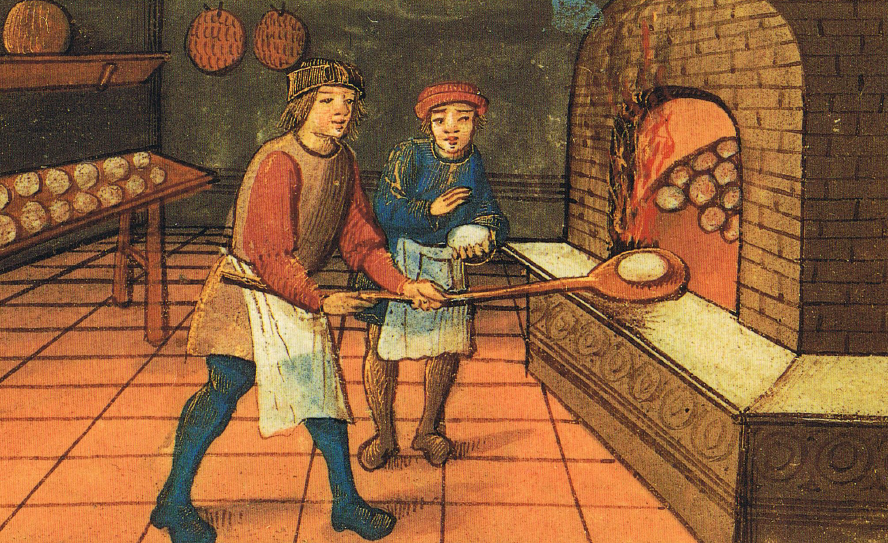

|
  (Also recorded as: manged, maunchett, maynche, maynchett, mayned, mengyd, meyned, manchete, manchett, manchet, mainchet, mancheat, mancheate, manched, manchuet, mayngate, maunchet, maincheat, manchent, manshut, manchette, manchit, mainchott, mainschoitt, mainschot, mainschott, manschet, manschot, manshote, manshott, mayneshet, mayneshott, maynshott, meaneschot, meaneschott, menschatt, menschoitt). The finest quality of white bread. An enriched or flavoured form of white bread, notably when hand-formed into flattish round loaves. The name occurs repeatedly in English manuscripts from the 14th Century to the early 19th, and may derive from the Old French word manche meaning a filter, suggesting a bread made from finest, ie. filtered, flour. As with many everyday food products 'manchet' is mentioned frequently, but information as to its composition is almost non-existent. That it was 'the very best' form of bread is largely inferred from context, and very occasional descriptions, such as in W. Harrison's 1577 'Historical Description of the Islande of Britain'; "Of breade made of wheat we haue sundry sortes..wherof the first and most excellent is the manchet, which we commonlye call white breade". The name is still, albeint rarely, used in Guildford Manchets and Bridgewater Manchits cf. 'Cheat' and Pandemain (occurs in Cury 1390, Digby 1669, WM 1658, etc).  Original Receipt in Huswife 1594; Original Receipt in Huswife 1594;The making of fine Manchet. TAKE half a bushel of fine flower twice boulted, and a gallon of faire luke warm water, almost a handful of white salt, and almost a pinte of yeast, then temper all these together, without any more liquor, as hard as ye can handle it: then let it lie half an hower, then take it up, and make your Manchetts, and let them stand almost an hour in the oven. Memorandum, that of every bushel of meal may be made five and twentie caste of bread, and every loafe to way a pounde beside the chesill. The making of manchets after my Ladie Graies use. TAKE two pecks of fine flower, which must be twice boulted, if you will have your manchet very faire: Then lay it in a place where ye doe use to lay your dowe for your bread, and make a litle hole in it, and put in that water as much leaven as a crab, or a pretie big apple, and as much white salt as will into an Egshell, and all to breake your leaven in the water, and put into your flower half a pinte of good Ale yeast, and so stir this liquor among a little of your flower, so that ye must make it but thin at the first meeting, and then cover it with flower, and if it be in the winter, ye must keep it verie warm, and in summer it shall not need so much heate, for in the Winter it will not rise without warmeth. Thus let it lie two howers and a half: then at the second opening take more liquor as ye thinke will serve to wet al the flower. Then put in a pint and a half of good yeast, and so all to break it in short pieces, after ye have well laboured it, and wrought it five or six times, so that ye bee sure it is throughlie mingled together, so continue labouring it, till it come to a smoothe paste, and be well ware at the second opening that ye put not in too much liquor sodenlie, for then it will run, and if ye take a little it will be stiff, and after the second working it must lie a good quarter of an hour, and keep it warme: then take it up to the moulding board, and with as much speed as is possible to be made, mould it up, and set it into the Oven, of one pecke of flower ye may make ten caste of Manchets faire and good. White 1932 records 'Lady Arundel's Manchet' of 1676 as being made from "a bushel of fine wheat flour, twenty eggs, and three pounds of fresh butter, as to the ordinary manchet, temper it with new milk pretty hot ... work it up into bread and bake it and let not your oven be too hot". The 1589 'Haven of Health' has; "in England our finest manchet is made without leaven", though this may mean that it was made without added leaven such as yeast, but was made rise by being allowed to absorb airborne bacterial leaven, after the manner of sourdough bread. For other traditional bread types, see: Cheat Jannock Bread Manchets Pandemain Wastel Bread Whigs For receipts mentioning manchet, see: Banbury Cakes Bisket Bread (1) Cabbage Cream Carrot Pudding-Pie Cheat Cheese Cake or Curd Tart Cornish Manchants Curd Loaf Fried Bread Gingerbread Great Oxfordshire Cake Guildford Manchets or Guildford Rolls Hasty Pudding Jannock Bread Misers New College Pudding Norfolk Fool Oxford Cakes Pamperdy Pandemain Posset Prince Biscuits Scrambled Eggs on Toast Spinach Fritters Wastel Bread  |
|
MORE FROM Foods of England... Cookbooks ● Diary ● Index ● Magic Menu ● Random ● Really English? ● Timeline ● Donate ● English Service ● Food Map of England ● Lost Foods ● Accompaniments ● Biscuits ● Breads ● Cakes and Scones ● Cheeses ● Classic Meals ● Curry Dishes ● Dairy ● Drinks ● Egg Dishes ● Fish ● Fruit ● Fruits & Vegetables ● Game & Offal ● Meat & Meat Dishes ● Pastries and Pies ● Pot Meals ● Poultry ● Preserves & Jams ● Puddings & Sweets ● Sauces and Spicery ● Sausages ● Scones ● Soups ● Sweets and Toffee ● About ... ● Bookshop ● Email: [email protected] COPYRIGHT and ALL RIGHTS RESERVED: © Glyn Hughes 2022 BUILT WITH WHIMBERRY |